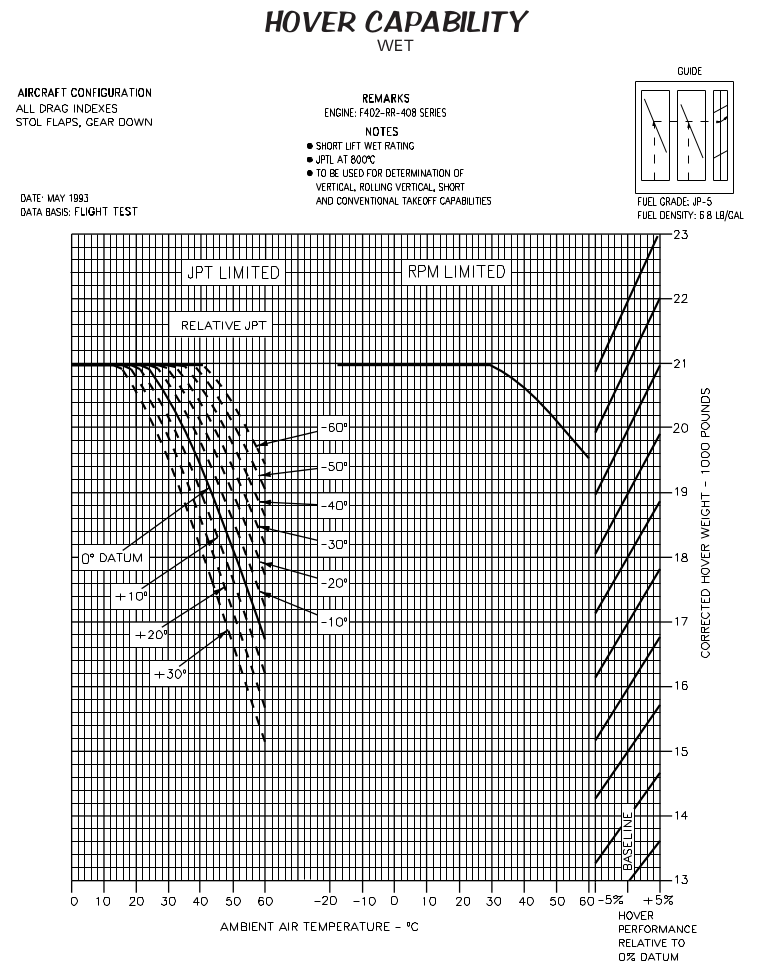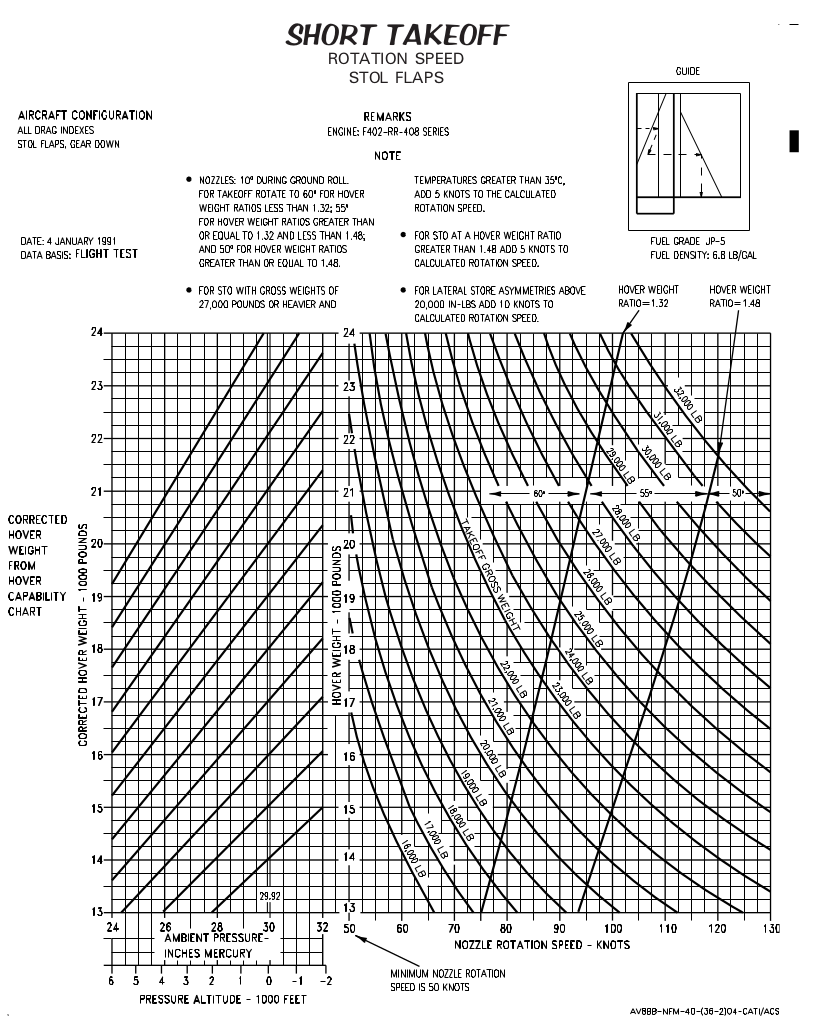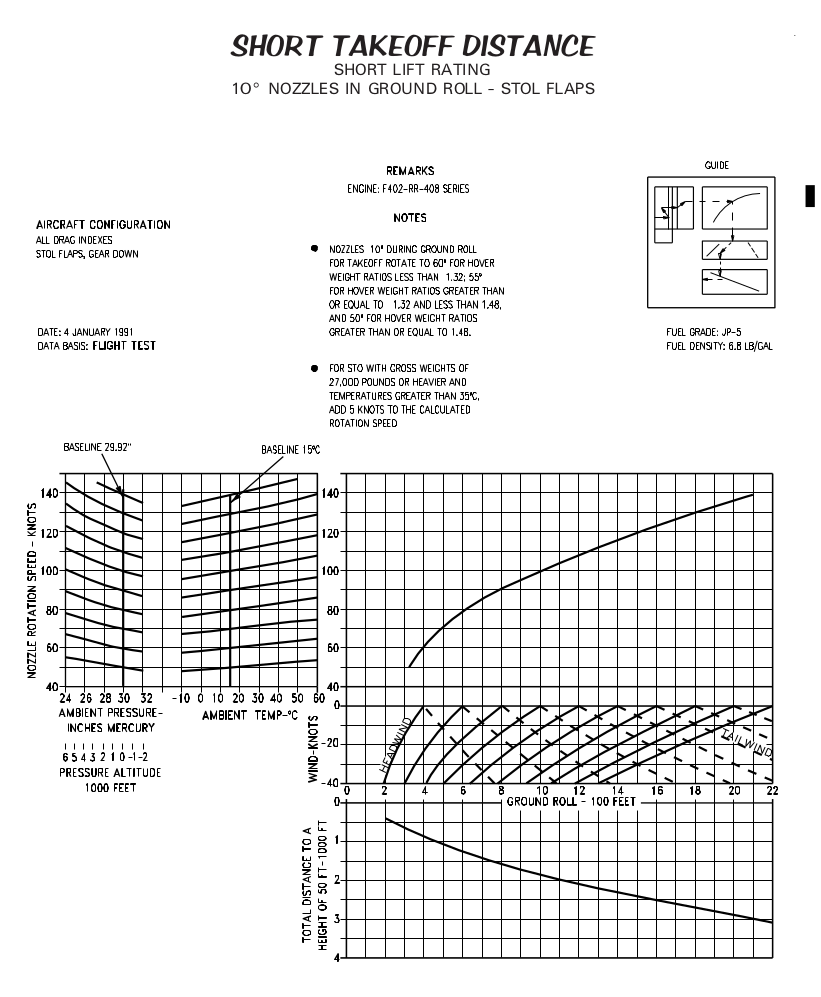I was looking for this information as part of my still-forthcoming Harrier blog post, and couldn’t find it anywhere. So, here it is: a quick table of Harrier II short takeoff rolls by gross weight and headwind, assuming the Pegasus -408/11-61 engine, standard temperature and pressure (15 degrees Celsius, 29.92″Hg), and 0% datum hover performance.
| Gross Weight | Takeoff Roll (no wind) | Takeoff Roll (20kt headwind) |
|---|---|---|
| 20000 lb | 400 ft. | 275 ft. |
| 22000 lb | 450 ft. | 325 ft. |
| 24000 lb | 550 ft. | 375 ft. |
| 26000 lb | 725 ft. | 500 ft. |
| 28000 lb | 1025 ft. | 750 ft. |
| 30000 lb | 1350 ft. | 1000 ft. |
Sources and Charts
These numbers come from the Harrier II NFM-400 manual. Please don’t share the download link off-site; it’s a fairly large PDF, and we’re pretty shoe-string budget-wise.
The relevant charts are reproduced below.

To use the hover capability chart, enter from the bottom, beneath the JPT half of the chart, from the appropriate ambient air temperature. Move up to the 0-degree datum line. Then, enter the chart from the bottom, beneath the RPM half of the chart, from the ambient air temperature. Move up to the RPM limit line. From the lower of the two intersections, move right to the hover performance 0% datum line without following the adjustment guidelines.
The JPTL adjustment values are maintenance-provided and outside the scope of my table. To use them, move up to them rather than to the 0-degree datum line. The hover adjustment guidelines are also out of scope. To use them, after moving right to the 0% datum, follow the guidelines up or down.
For 15C, neither JPT or RPM limits performance. Move across the chart to the 0% hover performance datum and read from there: 21,000 lb.

To use the nozzle rotation airspeed chart, enter from the left using the corrected hover value from the hover chart. Move straight across to the 29.92″Hg datum. Move parallel to the guidelines to the ambient pressure.
From there, move straight across to the takeoff gross weight. Stop at the intersection, move directly downward, and read the nozzle rotation airspeed off the bottom of the chart.
For a 22,000lb gross weight, start at 21,000lb, the corrected hover weight, and move across to the 29.92″Hg datum. Since the pressure is 29.92″Hg, continue moving directly across to the 22,000lb gross weight line. At the intersection, move down the chart to find the nozzle rotation airspeed of about 63 knots.

To use the takeoff chart, enter from the top left using the nozzle rotation airspeed calculated before. Move horizontally to the 29.92″Hg datum, then move parallel to the pressure guidelines to the ambient pressure. Move horizontally to the start of the temperature guidelines, then parallel the temperature guidelines to the ambient temperature. From there, move horizontally to the curved line to the right. At the intersection, move down to the zero-wind line at the top of the ground roll chart to find the 0-knot takeoff roll. Follow the solid line down the chart to the appropriate line to find the headwind takeoff roll.
To continue the example, enter the chart at 63 knots and move to the pressure baseline at 29.92″Hg. Move horizontally left to the start of the temperature guidelines, and parallel them to the 15C baseline, at about 66 or 67 knots. Move horizontally to the reflector line, then move vertically to find the takeoff roll of roughly 450 feet. Parallel the solid headwind guidelines down to a 20-knot wind to find the headwind takeoff roll of about 325 feet.
Brief Comments
Experience with DCS Harrier suggests that these numbers include a good deal of margin. I have no trouble getting off the Tarawa deck with at least 200 feet to spare, even at loads north of 30,000 pounds. These are, however, the by-the-book numbers.
Pingback: Retro Procurement: Harriers for Luchtburg? | The Soapbox